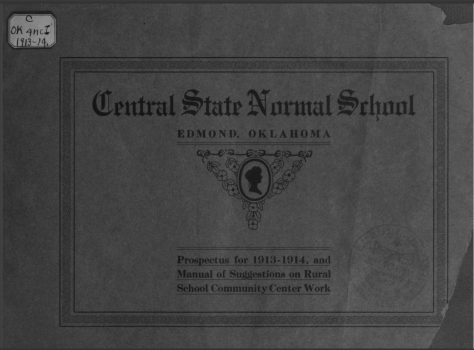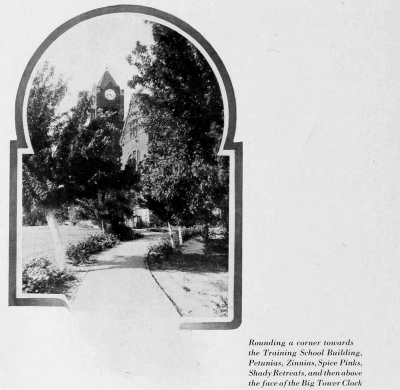Oklahoma History: April 2018 Archives
Amongst the discussion about education funding in Oklahoma is the claim that the large proportion of teachers with emergency or alternative certification is a danger sign -- we can't staff our schools with teachers that have the proper credentials. Getting the proper credentials involves taking certain courses in educational philosophy and method and some amount of student teaching.
Thinking back to my teachers at Holland Hall in the 1970s, very few of them had degrees in education. They had at least a bachelor's degree, typically in the field they were teaching, but they also had enthusiasm and a gift for communicating with students. The same is true of the teachers that my children have had in their private school experience.
In light of that, I thought it would be interesting to look back at the early days of teacher training. Oklahoma has six regional colleges that began life as normal schools, institutions for training teachers: University of Central Oklahoma, Northwestern Oklahoma State University, Southwestern Oklahoma State University in old Oklahoma Territory, and Northeastern State University, East Central University, and Southeastern Oklahoma State University in old Indian Territory. Langston University served a dual role: Its name at birth was the Oklahoma Colored Agricultural and Normal University, serving as the "separate-but-equal" Morrill Act counterpart to Oklahoma A&M and as a teachers' school for the African-American population.
A large number of other state universities began life as normal schools, including Illinois State University (in Normal, Illinois), Indiana State University, UCLA, and several branches of the SUNY system. What made a normal school normal was that students would be taught a particular set of norms for common education. This would include not only theoretical instruction but classroom experience, often by means of teaching children attending a training school attached to the normal school.
The oldest of Oklahoma's erstwhile normal schools is UCO, which began life in 1891 as Territorial Normal School. After the territorial legislature established Southwestern and Northwestern, it was renamed Central State Normal School. The Central State Normal School prospectus for 1913-1914, a 32-page brochure aimed at prospective students, is available on the Internet Archive, and it's fascinating reading. It tells us a lot about attitudes and expectations for public education a century ago.

What Central State Normal offered prospective teachers were certificates which would free them from having to take certification tests -- "grinding examinations" -- on a regular basis in order to get a job teaching. If you already had at least three years of high school, you could study for three terms at Central and get a certificate good for two years "in any county of Oklahoma." If you had a high school diploma, six terms at CSN would earn you a State Life Diploma -- a permanent certification to teach. The terms could be non-consecutive -- studying summers while teaching. The summer session of 1913 attracted 1,286 students. Teachers in districts that begin in late fall -- perhaps delayed because of the cotton harvest -- could take the opportunity to attend CSN for the fall term as well. For those students who could not come to Edmond, CSN offered correspondence courses, but you could only take one per year, and you still needed a year on campus for a diploma.
Students with only an eighth-grade education could come to CSN for a four-year preparatory course (high school) followed by the two year sequence of college-level teaching courses. Students could major in science, foreign languages (German, French, or Latin), or elementary teaching; the differences between majors were seen mainly in the high school years.
WILL YOU HEED THE CALL?There is a call constantly going out--give us a trained teacher for primary grades, principals and superintendents.
Students completing three years of high school work and doing satisfactory work for one year will be entitled to the Two-Year State Certificate. Students completing the Four-Year Normal Preparatory Course or a course equivalent to a standard four-year course in high school will receive a Two-Year State Certificate. This entitles the holder to teach in any county of Oklahoma for two years immediately following issuance.
Students completing a four-year high school course may take thirty-six weeks' work here and receive the Elementary State Certificate and at the same time have advanced to within one year of the State Life Diploma. To secure a State Two-Year Certificate, to become independent of grinding examinations for two years, to possess a license to teach and acquire funds to enter school again, to have the profit and pleasure of a year in a great state institution of learning and to get within one year of the State Life Diploma good in this and twenty more states of America, is the largest privilege ever granted to a high school graduate. Would it not pay you to begin right now to get this training? The school year consists of three regular twelve week terms -- fall, winter, spring -- and one summer term equivalent in every way to a regular term....
We extend to all friends of education a cordial invitation to visit Central State Normal over the hourly trolley from Oklahoma City, or Santa Fe.
The college-level requirements included two terms of psychology, two terms of pedagogy, two terms of advanced composition, three terms of observation and teaching, two terms of history of education, a term of philosophy of education, three terms of either manual training or domestic science, two terms of a teachers course, and a term of something called "Ind. Geog." Students following the elementary teacher's preparatory course took some of those classes during their high school years, leaving room in the two college years for courses like genetic psychology, child study, sociology, and advanced pedagogy.
The prospectus put a great deal of emphasis on Central's progressive and modern outlook, with modern technologies like a motion picture machine, Kodaks, and a phonograph available, and put forward the teacher as an agent of progress in Oklahoma communities, using school facilities for much more than teaching grade-school children. That's worth further exploration in another entry, but the crusading tone reminds me very much of Carol Kennicott, the central character of Sinclair Lewis's Main Street.

CNS boasted that it was easily accessible from anywhere, as there was an hourly trolley to Edmond from Oklahoma City from 6 a.m. to midnight, as well as service from Oklahoma City via steam train on the Santa Fe railroad.
TO THE OKLAHOMA CITY, EL RENO, AND YUKON HIGH SCHOOL GRADUATES RESIDING NEAR TROLLEY LINE.Over fifty Oklahoma City high school graduates came to Central State Normal this summer. There was a reason. Here it is: Central State Normal is on the hourly trolley line with Oklahoma City. This puts the oldest and largest State Normal School at the front gate of every pupil along the trolley line. To the high school graduate of Oklahoma City, and all towns along the trolley system, Central State Normal says: "Attend school here three terms taking proper credits and you will be awarded a Two Year State Certificate, recognized in any county, town, etc., of Oklahoma." It matters not whether these three terms be taken consecutively or not. Three summer terms will make a complete year. Add to these three terms another year's work in this school and you have a Life Diploma, freeing you from all examinations, and introducing you to the best position in education in this state and to all throughout the land. Besides this, you have done two years of college work and will be given equivalent credits in any College or University for such advancement.
So the Oklahoma City, the El Reno and other high school graduates in towns along the trolley line have a Two Year State Certificate within their grasp by three terms' work -- a Life Diploma, by six terms' work.
What wonder then that the high school graduates of these places are buying reduced rates over the trolley line to Central State Normal and thereby working out one of life's greatest opportunities?
Of the 30 faculty members, only 4 had master's degrees and an additional 10 had bachelor's degrees. No degree is listed for the remaining 16. It would be another five years before the school would be authorized to offer a four-year degree. At that point in time, a high school diploma was considered sufficient to teach students through eighth grade, but modern schools would have wanted teachers to have the additional training afforded by a normal school.